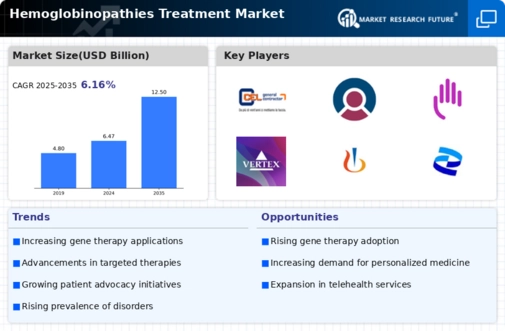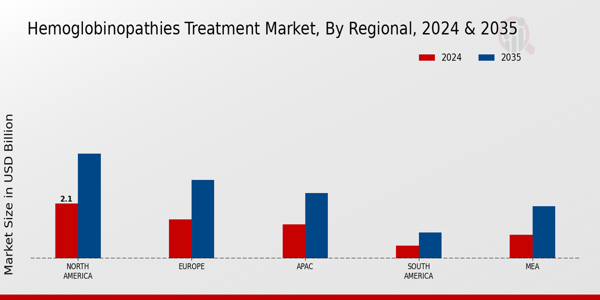Market Growth Projections
Advancements in Gene Therapy
Recent advancements in gene therapy are poised to revolutionize the Global Hemoglobinopathies Treatment Market Industry. Innovative techniques, such as CRISPR and lentiviral vector systems, are being explored to provide curative solutions for hemoglobinopathies. These therapies aim to address the root genetic causes of disorders, potentially offering long-term benefits to patients. As clinical trials yield promising results, the market is likely to witness increased investment and interest from pharmaceutical companies. This trend could significantly enhance treatment options available to patients, contributing to the overall market growth projected to reach 12.5 USD Billion by 2035.
Rising Awareness and Screening Programs
Increased awareness of hemoglobinopathies and the importance of early diagnosis are contributing to the growth of the Global Hemoglobinopathies Treatment Market Industry. Public health campaigns and screening programs are being implemented in various countries, particularly in high-prevalence regions. These initiatives aim to educate communities about the symptoms and risks associated with hemoglobin disorders, encouraging individuals to seek medical advice. As more patients are diagnosed and treated, the demand for effective therapies is likely to rise, further propelling market growth. This trend underscores the critical role of awareness in shaping treatment landscapes.
Increasing Prevalence of Hemoglobinopathies
The Global Hemoglobinopathies Treatment Market Industry is experiencing growth driven by the rising incidence of hemoglobin disorders such as sickle cell disease and thalassemia. According to health statistics, millions of individuals are affected globally, particularly in regions like Africa and Southeast Asia. This increasing prevalence necessitates the development and availability of effective treatment options. As awareness grows, healthcare systems are compelled to allocate more resources towards managing these conditions, thereby expanding the market. The projected market value is expected to reach 6.47 USD Billion in 2024, indicating a robust demand for innovative therapies.
Regulatory Support for Innovative Therapies
The Global Hemoglobinopathies Treatment Market Industry is experiencing favorable regulatory environments that support the development and approval of innovative therapies. Regulatory agencies are increasingly expediting the review processes for new treatments, particularly those addressing unmet medical needs in hemoglobinopathies. This proactive approach not only accelerates patient access to novel therapies but also encourages pharmaceutical companies to invest in research and development. As a result, the market is likely to see a surge in new product launches, enhancing treatment options for patients and contributing to overall market expansion.
Growing Research and Development Investments
The Global Hemoglobinopathies Treatment Market Industry is benefiting from heightened investments in research and development by both public and private sectors. Governments and health organizations are increasingly recognizing the need for innovative treatments, leading to funding initiatives aimed at developing new therapies. This influx of capital is facilitating the exploration of novel drug candidates and treatment modalities. As a result, the market is expected to expand at a compound annual growth rate of 6.17% from 2025 to 2035. Such investments not only enhance treatment options but also improve patient outcomes, thereby driving market growth.






















